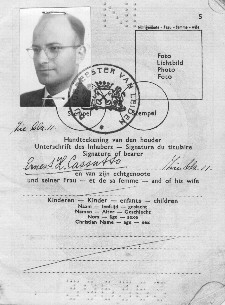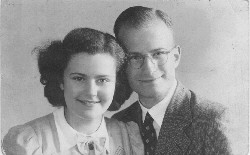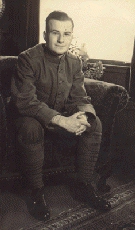

 Dr. Issac Cassutto settled in Probolingo, Indonesia in 1915 during
World War I, a conflict in which his nation, the Netherlands, was neutral.
His second son, Ernest, was born on December 1, 1919 just after the Treaty
of Versailles had been signed. The family moved to Bandung on the island
of Java as Issac found a teaching position in the area of Dutch colonial
law. Ernest grew up aware of his Jewish heritage, but his family was by no
means active in religious affairs.
Dr. Issac Cassutto settled in Probolingo, Indonesia in 1915 during
World War I, a conflict in which his nation, the Netherlands, was neutral.
His second son, Ernest, was born on December 1, 1919 just after the Treaty
of Versailles had been signed. The family moved to Bandung on the island
of Java as Issac found a teaching position in the area of Dutch colonial
law. Ernest grew up aware of his Jewish heritage, but his family was by no
means active in religious affairs.Ernest's family moved back to the Netherlands in 1934. It was a great transition from
 |
 Ernest was inducted into the Dutch
army, but was discharged shortly thereafter to return to school. The world
waited to see what Hitler would do during the period of late 1939 to early
1940 called the sitzkrieg, where both the Allies and the Axis
powers watched and waited while amassing arms and assessing each other's
strength and weaknesses. Hitler was preparing for a massive attack
westward.
Ernest was inducted into the Dutch
army, but was discharged shortly thereafter to return to school. The world
waited to see what Hitler would do during the period of late 1939 to early
1940 called the sitzkrieg, where both the Allies and the Axis
powers watched and waited while amassing arms and assessing each other's
strength and weaknesses. Hitler was preparing for a massive attack
westward.Germany invaded Holland on May 5, 1940. The military conquest of the small nation was completed in five days, along with that of Belgium and Luxemburg. Within one year of the Nazi occupation, the Jewish population of Holland came under severe persecution. By May of 1942, all Jews had to register with the Gestapo, the German secret police, and all Jews had to wear a yellow star of David to identify themselves in public as Jews. If one had three out of four grandparents who were Jewish according to Nazi racial policies, one was required to follow these restrictions.
Round-ups of Dutch Jewish citizens had begun in 1941, moving to full scale
arrests and deportations by late 1942. Ernest and Hetty decided to go into
hiding together in summer of 1942. Sometime in 1943, the couple was
separated. Ernest later learned that Hetty had been arrested by the
Gestapo. He would never see her again. She died in Auschwitz in January
of 1944.
|
|
Ernest had gone underground, meaning that he went from safehouse to safehouse seeking refuge from Nazi arrest. This hide-and-seek went on until March of 1944, when his hiding place had been discovered by the Nazis. Ernest's family had separated and survived the war without being discovered by their Nazi occupiers (but Ernest's older brother Max had been captured by the Japanese as they overran Indonesia, where he had made his home. Max would not see his wife and newborn son for five years). |
|
Ernest's brother Max and his bride |
Interrogation by the Gestapo was painful and humiliating. Ernest was taken to the headquarters of the Security Police in Rotterdam, a major port city in the southwest of Holland. Rotterdam had experienced terrible bombing by German forces in 1940. It was there that Ernest was questioned on the whereabouts of his family, other Jews, and the activities of the Dutch underground. Solitary confinement involved imprisonment in a small five by seven foot cell with a thick steel door. Upon it was posted the yellow star of David that Ernest had been forced to wear, indicating the status of the prisoner contained within. The prison also housed criminals, those who had been deemed anti-social by the Nazis, homosexuals, pacifists, and communists, all bound for the firing squad or deportation to slave labor or extermination camps in Germany and Poland. Ernest was given starvation rations of tulip bulbs and sugar beets fried in grease. He was totally alone, except for a Bible that his Nazi captors allowed him to read, and the newfound faith he had discovered while in hiding.
He expected to be included in the final deportations of Jews from Holland to the East. The war was going poorly for the Germans, and an invasion of Hitler's "Fortress Europe" was imminent. The Nazis were attempting to complete what had come to be called the "Final Solution" on the order of a leader who had been growing increasingly unstable and irrational. Only a few months later, his own generals would attempt an assassination (July, 1944). It was in this atmosphere that the final deportations and exterminations were being carried out. Somehow, the yellow star on Ernest's door had been removed, and he had been left behind. The Germans would later call him "The Last Jew of Rotterdam".
| Ernest was assigned to slave labor outside Rotterdam during the time that the Allies were racing across western Europe into the heart of what was left of Nazi Germany. During this time, Ernest had befriended a member of the Dutch civil police force, who was in contact with the Dutch underground. As they moved to and from the slave labor camps, the guard obtained a pass for what Ernest was told would be his "final shower." Instead, the guard and his charge left the camp and went into hiding. Two days later, on May 5, 1945, Canadian and British forces liberated Holland. Ernest was reunited with his family, who had survived in tact. But 150,000 Dutch Jews would not return from the camps. Germany surrendered on May 7, 1945. |
|
|
Ernest's younger brother |
The story, of course, does not end here. To find out how Ernest met Elisabeth, read the epilogue. But first, learn about the experiences of Ernest's future wife, Elisabeth Rodrigues.